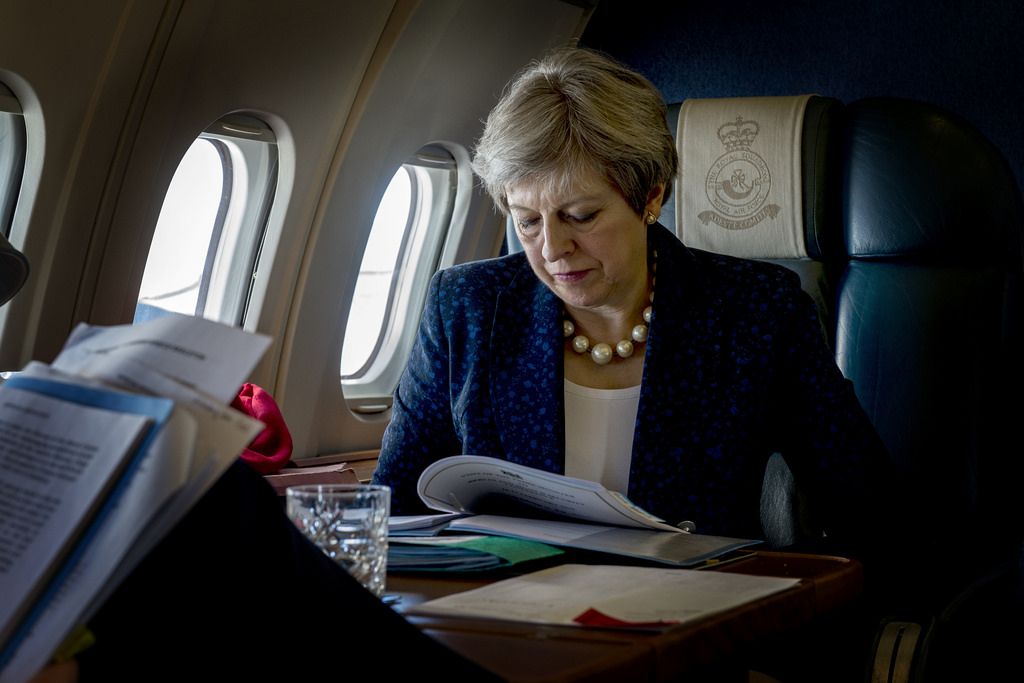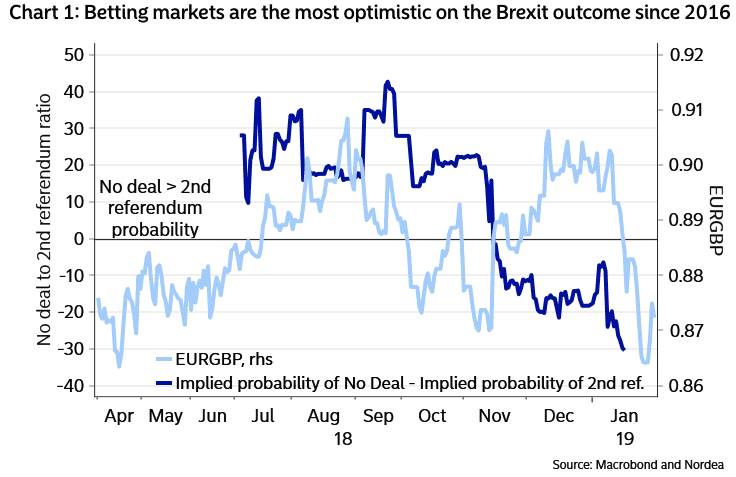Sell Pound Sterling, buy the Euro, May's Hunt for Unicorns Won't Succeed: Nordea Markets

Above: It's back to Brussels for Theresa May. File photo. Image by Jay Allen © Crown Copyright
The British Pound was seen over half a percent down against the Euro in the run-up to the weekend with the Pound-to-Euro exchange rate quoted at one-week lows at 1.1377, having been as high as 1.1577 on Monday.
The declines dovetail with a call by foreign exchange strategists at Nordea Markets to sell Pound Sterling on the basis markets have become too optimistic in expecting a resolution to the current Brexit saga as Prime Minister Theresa May is seen to be on a hiding to nothing in her quest to secure further significant concessions from Brussels.
Andreas Steno Larsen, a strategist with Nordea Markets - the Scandanavian lender and investment bank - says 'no deal' risks are "too complacently priced by markets and the GBP may suffer consequently over the coming weeks".
As we can see in the below, the Euro-to-Pound exchange rate tends to track the betting market's expectations for a deal or no deal. The Pound has therefore become a binary 'deal' or 'no deal' punt.
"The most important driver behind Sterling strength over the past few weeks has been the reduced probability of a no-deal scenario, which a large majority of MPs are determined to avoid," says Kathrin Goretzki, FX Strategist with UniCredit Bank in London.
The call to sell the Pound by Larsen and his colleagues stands in direct contrast to the strategy being maintained at Wall Street giant Morgan Stanley who advocate buying the Pound on dips as they believe a Brexit deal will still likely be achieved by March 29.
Larsen sees no exit from the current Brexit impasse as the EU is not willing to renegotiate, "while May still dosn’t know what to ask for" and the UK is therefore inching closer to a 'no deal'.
As is usually the case in negotiations, it is in the negotiator's best interest to keep intentions secret until both sides are at the negotiating table, we therefore don't share this assessment and would expect the UK to have specific requests of the European Union.
UK Foreign Secretary Jeremy Hunt told BBC radio on Thursday the government will take a few days to formulate proposals to put to the European Union in an attempt to resolve the issue of the Irish backstop.
"We will put those proposals together. It is going to take a few days to do that," says Hunt. "I happen to believe there is potential along all the different routes that have been discussed. But we need to put those together, make sure they meet the concerns the EU has expressed and then I think, we will have a proper discussion".
"Theresa May will travel to Brussel to ask for a unicorn and will return empty-handed," says Larsen, adding he finds it hard to justify the current Brexit optimism and would put a larger subjective probability on the 'no deal' risk than markets do..
The UK is moving closer to a "managed 'no deal' exit", says Larsen.
Nordea suggest being long EUR/GBP, targeting levels of at least 0.8950.
A EUR/GBP target at 0.8950 equates with a Pound-to-Euro exchange rate target at 1.1173, at the time of writing the pair is quoted at 1.1454.
Time to move your money? Get 3-5% more currency than your bank would offer by using the services of foreign exchange specialists at RationalFX. A specialist broker can deliver you an exchange rate closer to the real market rate, thereby saving you substantial quantities of currency. Find out more here.
* Advertisement
The strategy advocated by Nordea Markets is shared by Rory Manley, a trader with UBS who this week told clients "more Brexit pain is needed before markets can price a true bull case for UK assets."
This week saw UK Prime Minister Theresa May win the backing of MPs to return to Brussels and renegotiate the Irish border backstop. Speaking after a series of parliamentary votes, May argued she now has a mandate to seek from the EU changes to the backstop.
Any positive scenario for the Pound and UK assets would be founded on a negotiated deal for leaving the European Union; "all other routes risk Government instability and early elections," says Manley. "Things will not get better straight away and I still recommend being underweight UK assets and short GBP."
UBS expect initial conversations and the EU's reaction to deliver further negative newsflow for Sterling in the short-run, noting the risk this fragile compromise falls apart is significant and the EU negotiation will be negative to start.
"The Prime Minister will not be able to deliver a bargain that satisfies all of the demands, but she is now equipped with three key things: the threat of ‘no deal’, the sense she is listening to concerns and the running down the clock a bit further. Further down the line, that will help shift some of the pressure off the government and onto the Members of Parliament to back her deal," says Manley.
UK Negotiation Team Announced, May Pursues Malthouse Compromise
The UK will send three senior politicians to negotiate with Brussels on the issue of the Irish backstop.
That three politicians have been selected suggest negotiations won't be headed by a civil servant; previously civil servant Ollie Robbins lead the technical negotiations, taking direction from the Prime Minister.
According to a report in the Times, David Lidington, the prime minister’s de facto deputy, and a former Europe minister "who is widely respected in Brussels" is expected to lead the talks. He will be supported by Stephen Barclay, the Brexit secretary, and Geoffrey Cox, the attorney-general.
Ollie Robbins, May’s chief Europe adviser who led the detailed negotiations on the withdrawal agreement, would have a less prominent role.
This shake up will likely please Brexiteers who have been highly critical of Robbins and argue a more robust political figure should be representing the UK's position at the negotiating table.
In other reports, May will meet the group of lawmakers behind an alternative Brexit proposal later on Thursday, her spokesman said.
May will be meeting with MPs behind the so-called 'Malthouse Compromise' plan. The plan, named after Kit Malthouse, appeals to 'Brexiteers' through a promise to ditch the unpopular Irish border policy in favour of an alternative.
It meanwhile appeals to 'Remainers' by pledging safeguards against the risk of disruption if no exit deal can be agreed with Brussels.
What is the Malthouse Compromise?
The following explainer of the Malthouse plan comes courtesy of William James at Reuters:
Plan A
The group backs an alternative withdrawal agreement, which is closely modelled on the existing agreement, but includes a different backstop arrangement.
The new backstop would be based around a zero-tariff free trade agreement rather than its current basis of a shared customs area between Britain and the EU. It relies on technological solutions to move checks on goods away from the border. This proposal was first announced in December.
Plan B
If negotiations with Brussels fail, the government should seek a basic transition agreement involving an offer to keep paying into the EU and guaranteeing the rights of EU citizens living in Britain.
In return, Britain wants to extend current trading terms beyond the end of the 'implementation' period - utilising a clause in international trade law - if a permanent trade arrangement has not been agreed by then. May's rejected divorce deal envisages a transition, or implementation, period till the end of 2020 during which trade would continue on current terms.
Time to move your money? Get 3-5% more currency than your bank would offer by using the services of foreign exchange specialists at RationalFX. A specialist broker can deliver you an exchange rate closer to the real market rate, thereby saving you substantial quantities of currency. Find out more here.
* Advertisement





